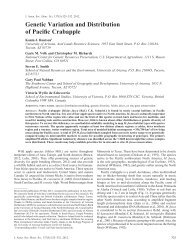CONSERVATION
Conservation You Can Taste - The Southwest Center - University of ...
Conservation You Can Taste - The Southwest Center - University of ...
- No tags were found...
Create successful ePaper yourself
Turn your PDF publications into a flip-book with our unique Google optimized e-Paper software.
EMERGING CHALLENGES,<br />
OBSTACLES AND THREATS<br />
THE PREVIOUS sections suggest that over the last quarter century, the recovery<br />
of heritage food biodiversity has been one of the most cost-effective investments that<br />
private citizens, communities, philanthropic foundations, non-profit organizations<br />
and grassroots alliances have made in collaborative conservation over the last<br />
century. But despite recent successes, there are many emerging challenges, obstacles<br />
and threats that must still be dealt with. Among them are:<br />
A. Climate change and the displacement or destruction of rare crop and<br />
livestock populations after catastrophic weather events.<br />
B. Expanding distributions for pests, toxic weeds and diseases that may<br />
affect the health of rare plant or animal populations.<br />
C. Potential genetic contamination by GMOs of heritage varieties of corn,<br />
rice or other crops.<br />
D. Loss of pollinators required to assure seed and fruit set of rare food plants.<br />
E. “Green washing” in the commodity marketplace, hoping to capitalize<br />
on the buzz associated with heritage foods or heirloom vegetables.<br />
F. Unethical cultural appropriation, patenting or trade-marking of<br />
heritage foods that potentially disrupts the food sovereignty of indigenous<br />
communities, or of immigrant communities of traditional farmers.<br />
G. Unintended effects of food safety and zoning regulations limiting the<br />
production of heritage plants and animals which local artisans prepare into<br />
value-added products.<br />
H. Scarcity of trained livestock breeders or backyard/on-farm plant breeders<br />
required to keep heritage plants and animal populations dynamic, rather<br />
than having them relegated to the status of static museum pieces.<br />
70



